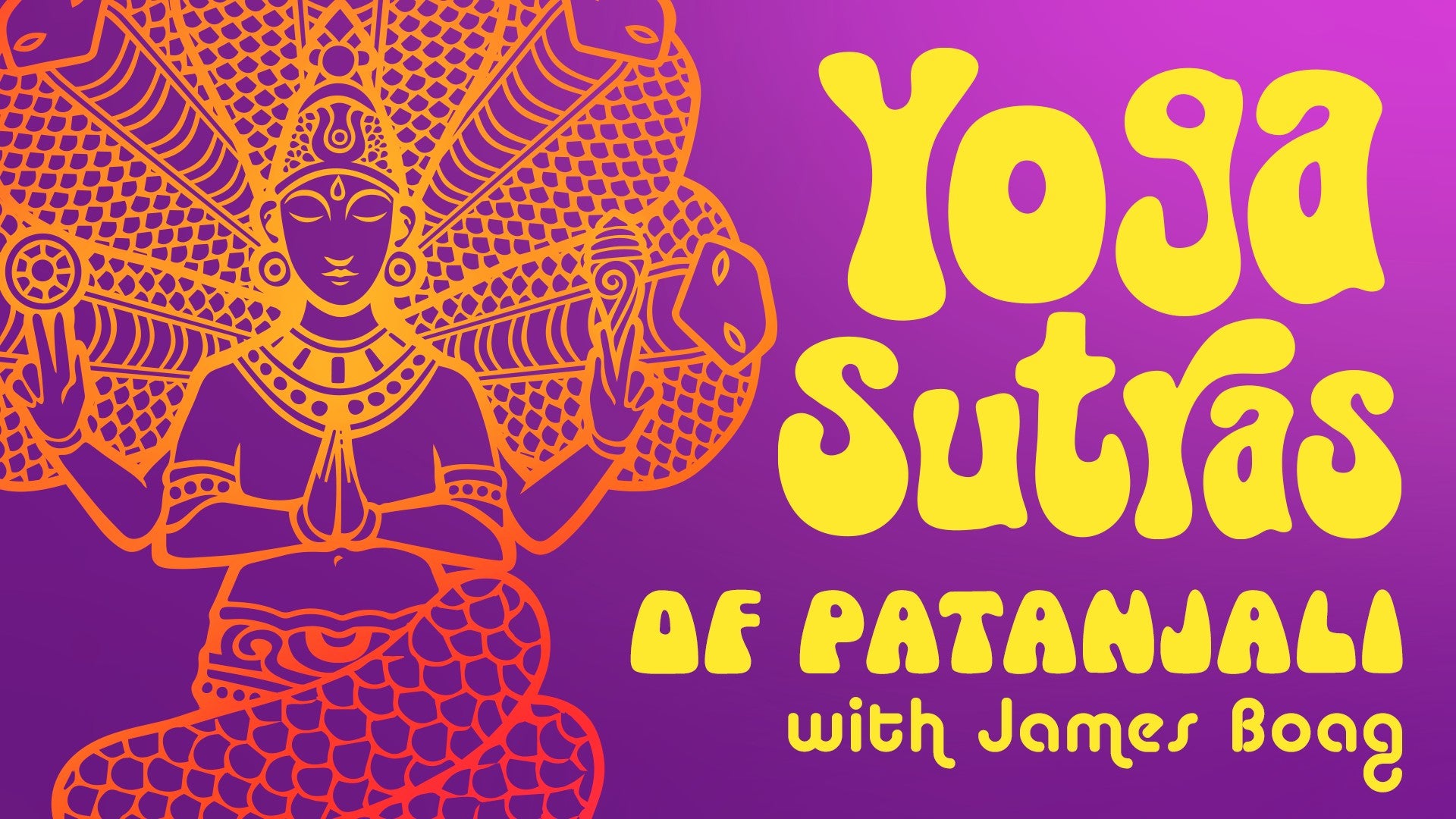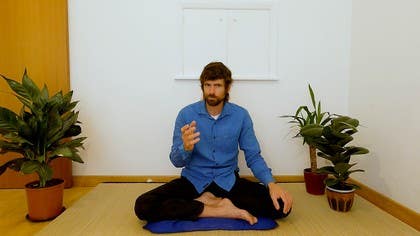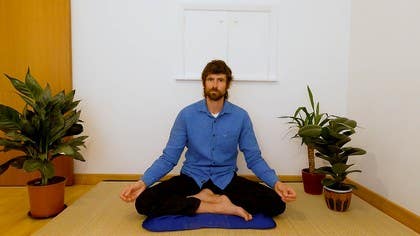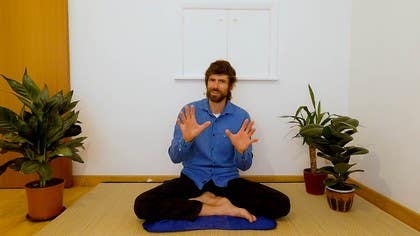Description
About This Video
Transcript
Read Full Transcript
Sutra 31 is an absolutely extraordinary Sutra. 21 syllables. In the sutras, we've noticed they're very, very concise. And they say in the Sanskrit tradition, if a Sutra Carter, a person who writes Sutra's, can trim the piece of work by a syllable, then you can have a celebration as if a grandchild has been born in your family. That's a big celebration.
So what that tells us is that the sutra form is all about concision. And syllables count. They're not wasted. So in sutra 30, Potently has told us what the yamers are. And now he says He says that these yamas are the Maha Vrata.
Now, the word Vrata means a vow. Not a promise, a vow. So what does a vow mean? It means something that you do not break. This is something that in a modern society, we seem to have lost a little bit of clarity about what that really means. So for example, we spoke of marriage vows, but in recent history, lots of people don't take the meaning of vow to what it means in this context of Rata is something that you do not break it. So if you take a Vrata, now you honor it.
Now, in the context of the yoga sutra of a sutra work, If potentials told us that these yamas are very important, it's the first thing in the list of this body of collective practice, Already, we know they're important, but now he describes the Yumas as the Vrata. So just those two syllables of Vrata What do they what does that tell us? It tells us what? These Yamas, they're an important thing. Okay. Well, I pay attention here. We didn't just the great vow, 4 syllables. So with those 4 syllables, Okay. These yamas, they're super important. But he doesn't stop with 4 circles. Now, he says, Sarava Beauma, Sarviboma, another 4 syllables.
So 8 syllables, Sarviboa means that all times in all places on all grounds and all situations, these are the great vow. So with those 8 syllables, we already know the Yamas are not just important. They're not just super important. They are mega important. But he doesn't stop there.
He says, Jati, Deshaqales, Samayan, Avachina, Sarba Balma, Mararita. He gives us another 11 syllables. Eleven, or is it 13? Jati, Deisha, color, Samayan, another 13 syllables, emphasizing just how super ultra mega important the yamas are. Jati means the situation of your birth, you know, what type of family you're born into, where you're born, what, you know, wherever you find yourself, the circumstances of your birth, your life situation, Deja, what place you are in, what culture you are born into, or doesn't know that matters.
Carla, what are the fashions or trends of the time? Doesn't matter. Samayana Vachinna, they are not altered by circumstances, saurvabama on all grounds, in all situations, These are the great vow. So what potentially is telling us here is that uhinsa, Satya, Esteeya, Brammacharya, and a Parigraha, These are the great vow to be observed, to be attended, to be cultivated, to be practiced at all times and all places. And this is one of the reasons why I don't think it's really fair or accurate to describe from Macharia, just as celibacy, because, as I mentioned already, potentially, is so humanitarian, so much graceful humanity is soaked through his text.
He's not against the continuation of the human race. And with any of the five yamers, these are things that we always observe, and this is why I prefer I don't think it's, again, accurate or really representational of the spirit of Potanjali to describe the Yamas as restraints. Or the don'ts, or the things that one needs to avoid, like, you know, don't harm, don't steal, don't tell lies. Yes. That is part of the Yamers, for sure. But he's telling us here, these are the great vow to be observed at all times in all places.
So this, to me, really emphasizes that these yamas They're not things we don't. They're things we do. They're things we practice and cultivate all the time. I mentioned that this is a standout, extraordinary sutra, nowhere else does potentially lay so many layers of emphasis upon emphasis. So we said already, just the word Vrata, emphasize it's super important. Mahabrata, it's greatly important.
Sarafa Balma Maharita. It's always an all type situation, greatly important. And then he gives the further distinction and it's not affected or altered by the circumstances of the time, the place, or the situation. So super important. These are things that we do, and this is a standout sutra in this second chapter.
What was the standout sutra linguistically in chapter 1. It was sutra 33. We mentioned sutra 34 to 39. They all contain the particle VAR. Meaning and or as well, in addition, optionally. But Sutra 33, no optionality. No Vaa.
What was potentially telling us in order to bring about the clarification of the chitter one needs to behave in 4 types of ways and in 4 types of situation. When things are agreeable, Be might be, be friendly, be open, when things are difficult, become passionate, when we see wonderful things that it inspires, lift us up, celebrate it, when we see terrible things, be studying, be equipized. So it's very striking to me that these 2 stand out Sutra's. I see that the Yamas are basically an elaboration of Sutra 33 in chapter 1. The Yamas are giving us a bit more of a bit more guidance as to how we can actually live our lives in the maelstrom of life, in the whirling wonder of change and transformation and unpredictability that is net bound to being counted in life, how we can navigate that in the yogic balanced way.
And in both chapters, the sutures that really stand out, they're both about how we relate to ourselves, to others, and to the broader environment. And here in chapter 2, the essential practice, all times, all places, is the observance cultivation practice of the Yamans. In chapter 1, the obligatory practice, Maetri, Karuna, Murita, Now these 4 qualities of Mafikodeaupikshan, they are elaborated in the Yamans. To me, that's very, very striking. Would I like to live in a neighborhood where everybody practiced being my 3 being friendly and open when things were agreeable? When everybody exercised compassion when there was suffering, where everybody celebrated when people did great things and let it inspire them.
And I lift them up. And when there was difficulty, when there was horror, when there was terror, everybody would be steady. And so we're able to meet those challenges from the most skillful place, balanced place possible. I'd love to live in a place like that. Similarly, I would love to live in a place where everybody was really cultivating these virtuous qualities that the yamers help connect us to. And that's one thing we can also see about this Mahabrata.
One of my Indian teachers says, He's a dramatic character. He says, betray your conscience and you're damned. Not in the sense of going to some eternal hellfire. But in the sense that one of the translations of the Gita with a commentary that I read 1 year was by let me get it right. It was for me Chin myananda.
And he says, one is not punished. Let me get this right. He says, one is not punished for one's sins. One is punished by one since. When we go against our own conscience, we set ourselves up for suffering.
Sooner or later, or perhaps more likely sooner and later. So Yammer and Niyamas, we'll see in a moment. These can be considered as lenses supports to help us tune in to our conscience. Does the idea that that pilot light of conscience is always a flame within us? The angel on our shoulder Gimini Cricket in the Pinocchio story is always with us, always giving guidance, but what happens often is that our through our conditionings and perhaps through various other influences, That voice can sometimes get shrouded or muffled by habits and tendencies and conditioned ideas and false beliefs.
And so the rehabilitation recovery program of yoga is about reclaiming and recovering that connection to the voice of conscience so we can heed it more clearly. So we can discern it. We can be guided by it with greater confidence. And Yamas and the practice of Yamas is really one of the very reliable, robust, and valuable ways to rehabilitate and fortify our connection to conscience. And conscience is really key here because the Yamas they're not a set of rules.
Yoga is far too practical. For rules. Yoga has been tested very, very thoroughly. Over many, many, many generations, over millennia. And so it's far too wise for limiting rules.
Yoga recognizes that sometimes There are situations in which that which would ordinarily be unconscionable is the appropriate action. I have said, I think it's in the mythology show, which you can also view here on yoga anytime. When I was talking about the archetype of ganesha. It's a kind of initiatory step along the path of yoga. If we're gonna access this that quality of spiritual heroism and yogic warriorhood, and we have to learn that any rule worth respecting will bear being broken for the sake of the principle that is designed to enshrine.
Sometimes the law is not just. Sometimes the law of the land is in blatant contravention. To cosmic law. Yoga would ask us to heed our conscience to align ourselves with dharma, with Rita, with that pulsation of the cosmic forces of existence. This is what we need to listen to, not the laws that have been imposed by some system that maybe has its own short term agenda, but to muster the courage and the deep presence to inquire what is really appropriate here?
Sometimes, our conscience will demand that we do things that are really quite challenging. This is what it means to become the sovereign of the field of our being. We have to claim that responsibility, and this is the great vow. If we practice this great vow, it will almost inevitably invite deeper presence. In order to practice this great vow, we have to have that constant spirit of inquiry.
Which is really the heart of yoga practice.







You need to be a subscriber to post a comment.
Please Log In or Create an Account to start your free trial.